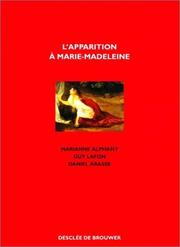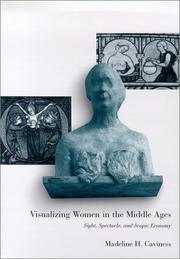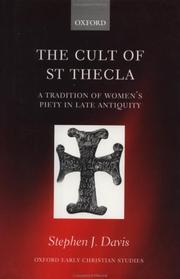| Listing 1 - 9 of 9 |
Sort by
|

ISBN: 1578564476 Year: 2001 Publisher: Colorado Springs, Colo. : WaterBrook Press,
Abstract | Keywords | Export | Availability | Bookmark
 Loading...
Loading...Choose an application
- Reference Manager
- EndNote
- RefWorks (Direct export to RefWorks)
Christian women saints --- Saintes chrétiennes --- Mary Magdalene,
Book
ISBN: 222731723X 9782227317239 Year: 2001 Publisher: Paris : Bayard,
Abstract | Keywords | Export | Availability | Bookmark
 Loading...
Loading...Choose an application
- Reference Manager
- EndNote
- RefWorks (Direct export to RefWorks)
" Marie-Madeleine [...] se montre à tous les tournants stratégiques de la vie de Jésus. Elle se montre et révèle. Même trop, et trop souvent au goût des évangélistes et des premiers apôtres, à commencer par saint Paul qui n'aura de cesse de la faire oublier. Elle nous aide à voir. Il faut alors procéder à l'inverse. Marie-Madeleine n'a pas de cheveux, si ce n'est dans les toiles des historiens d'art et la balbutiante concupiscence des transports mystiques. Elle n'a pas non plus le moindre corps que pourraient cacher lesdits cheveux de la " fausse blonde ". Marie-Madeleine n'existe pas. Ni vraie, ni fausse, sa vérité est ailleurs, d'un autre ordre. " Pierre-Emmanuel Dauzat
Book
ISBN: 2890746461 Year: 2001 Publisher: Boucherville, Québec : Editions de Mortagne,
Abstract | Keywords | Export | Availability | Bookmark
 Loading...
Loading...Choose an application
- Reference Manager
- EndNote
- RefWorks (Direct export to RefWorks)
Self-realization. --- Christian women saints --- Psychology and religion --- Réalisation de soi --- Saintes chrétiennes --- Psychologie et religion --- Biographies --- Mary Magdalene, --- Bible. --- Use.

ISBN: 1893302172 Year: 2001 Publisher: Tempe, Ariz. : Dandelion Books,
Abstract | Keywords | Export | Availability | Bookmark
 Loading...
Loading...Choose an application
- Reference Manager
- EndNote
- RefWorks (Direct export to RefWorks)
Christian women saints --- Women in the Bible --- Saintes chrétiennes --- Femmes dans la Bible --- Romans, nouvelles, etc. --- Romans, nouvelles, etc. --- Mary Magdalene, --- Fiction. --- Bible. --- History of Biblical events

ISBN: 2220049884 9782220049885 Year: 2001 Publisher: Paris Desclée de Brouwer
Abstract | Keywords | Export | Availability | Bookmark
 Loading...
Loading...Choose an application
- Reference Manager
- EndNote
- RefWorks (Direct export to RefWorks)
Christian art and symbolism --- Christian women saints --- Art et symbolisme chrétiens --- Saintes chrétiennes --- Mary Magdalene, --- Jesus Christ --- Art --- Resurrection --- 225-055.2 --- Vrouwen in het Nieuwe Testament --- 225-055.2 Vrouwen in het Nieuwe Testament --- Art et symbolisme chrétiens --- Saintes chrétiennes --- Art. --- Resurrection. --- Christian art and symbolism.
Book
ISBN: 8816435119 9788816435117 Year: 2001 Volume: 11 Publisher: Milano : Jaca book,
Abstract | Keywords | Export | Availability | Bookmark
 Loading...
Loading...Choose an application
- Reference Manager
- EndNote
- RefWorks (Direct export to RefWorks)
Empresses --- Christian women saints --- Impératrices --- Saintes chrétiennes --- Biography --- Biographies --- Biographie --- Adelaide, --- Holy Roman Empire --- Saint Empire romain germanique --- History --- Histoire --- Impératrices --- Saintes chrétiennes --- Biography. --- Empresses - Holy Roman Empire - Biography --- Adelaide, - Empress, consort of Otto I, Holy Roman Emperor, - 931-999

ISBN: 0812235991 Year: 2001 Volume: *46 Publisher: Philadelphia University of Pennsylvania Press
Abstract | Keywords | Export | Availability | Bookmark
 Loading...
Loading...Choose an application
- Reference Manager
- EndNote
- RefWorks (Direct export to RefWorks)
During the high Middle Ages in Europe, the act of looking was surrounded by superstition. It was believed to have magic power, it was able to arouse anxiety, and it was the subject of lengthy texts by both men and women. In Visualizing Women in the Middle Ages, Madeline H. Caviness interrogates twentieth-century theories of the gaze and concedes that the "male gaze"—first articulated by Laura Mulvey and a cornerstone of much feminist criticism—is useful for understanding a cultural code of patriarchy in the high Middle Ages. However, she argues, one should take into account the many varying visual modes that proliferated in the medieval era. For Caviness, an awareness of historical context places pressure upon contemporary theories like that of the "male gaze," changing their shapes and creating even richer dialogues with the past. In a series of readings, Caviness demonstrates how looking functions within the much broader contexts of language and desire. The Old Testament story of Lot yields the material with which Caviness addresses the Mulveian gaze. In the narrative and in medieval visual representations of the story, she explores the biblical proscription of and anxieties about women looking. She then turns to medieval depictions of the torture of female saints and investigates how such images were not erotic in the Romanesque abstract modes but became disturbingly sexualized and sadistic in the more graphic renditions of the Gothic. Finally, Caviness looks at the distribution of relics of female saints in relation to Lacan's notions of the abject. Here she shows how the female body is de-eroticized and re-encoded as parts become metonymies for the whole and are revered as holy objects.
Art [Medieval ] --- Art médiéval --- Femmes dans l'art --- Kunst [Middeleeuwse ] --- Medieval art --- Middeleeuwse kunst --- Vrouwen in de kunst --- Women in art --- Christian women saints in art --- Art, Medieval --- Saintes chrétiennes dans l'art --- History --- Histoire --- 7.04 --- Iconografie. Iconologie. Onderwerpen van kunstzinnige uitbeelding --- Art, Medieval. --- Women in art. --- 7.04 Iconografie. Iconologie. Onderwerpen van kunstzinnige uitbeelding --- Saintes chrétiennes dans l'art --- Art médiéval --- History. --- Femmes --- Dans l'art --- Moyen-Age --- Thèmes, motifs

ISBN: 0860788733 9780860788737 Year: 2001 Volume: CS733. Publisher: Aldershot Ashgate
Abstract | Keywords | Export | Availability | Bookmark
 Loading...
Loading...Choose an application
- Reference Manager
- EndNote
- RefWorks (Direct export to RefWorks)
Women --- Monastic and religious life of women --- Christian women saints --- Femmes --- Vie religieuse et monastique féminine --- Saintes chrétiennes --- Religious life --- Vie religieuse --- Empire byzantin --- Byzantine Empire --- Religious life and customs. --- Vie religieuse et monastique féminine --- Saintes chrétiennes --- Human females --- Wimmin --- Woman --- Womon --- Womyn --- Females --- Human beings --- Femininity --- Monastic life --- Monasticism and religious orders for women --- Spiritual life --- Christianity --- Byzantium (Empire) --- Vizantii︠a︡ --- Bajo Imperio --- Bizancjum --- Byzantinē Autokratoria --- Vyzantinon Kratos --- Vyzantinē Autokratoria --- Impero bizantino --- Bizantia --- Religious life and customs --- Women - Religious life - Byzantine Empire. --- Monastic and religious life of women - Byzantine Empire. --- Theodora Thessalonicensis --- Photina Samaritana --- Byzantine Empire - Religious life and customs.

ISBN: 0198270194 9780191568350 019156835X 9780198270195 9780199548712 1281998753 9786611998752 0199548714 Year: 2001 Publisher: Oxford New York
Abstract | Keywords | Export | Availability | Bookmark
 Loading...
Loading...Choose an application
- Reference Manager
- EndNote
- RefWorks (Direct export to RefWorks)
Thecla, a disciple of the apostle Paul, became perhaps the most celebrated female saint and 'martyr' in the early church. Bringing together literary, artistic, and archaeological evidence, the author shows how the cult of Saint Thecla was especially popular among early Christian women. - ;Thecla, a disciple of the apostle Paul, became perhaps the most celebrated female saint and 'martyr' among Christians in late antiquity. In the early church, Thecla's example was associated with the piety of women - in particular, with women's ministry and travel. Devotion to Saint Thecla quickly spread throu.
235.3 THECLA --- 235.3*15 --- Women in Christianity --- -Women in Christianity --- -Christianity --- 235.3*15 Hagiografie: vereringsgeschiedenis --- Hagiografie: vereringsgeschiedenis --- Hagiografie--THECLA --- History --- -History --- -Thecla Saint --- -Cult --- Cult --- -235.3*15 Hagiografie: vereringsgeschiedenis --- Femmes dans le christianisme --- Thecla, --- Heiligenverering. --- Cults. --- Christian Church --- Early church. --- Thècle, --- Christian women saints --- Saintes chrétiennes --- Histoire --- Cult. --- Christianity --- Ḟēkla, --- Tecla, --- Thècle, --- Thekla, --- History. --- Religion --- Culte --- Histoire. --- Egypt. --- Turkey --- Silifke Region (I?c ̧el I?li). --- Thecla. --- Philosophy & Religion --- Women in Christianity - Turkey - Silifke Region (Icel Ili) - History - Early church, ca. 30-600 --- Women in Christianity - Egypt - History - Early church, ca. 30-600 --- Thecla, - Saint - Cult - Turkey - Silifke Region (Icel Ili) - History --- Thecla, - Saint - Cult - Egypt - History --- Thecla, - Saint
| Listing 1 - 9 of 9 |
Sort by
|

 Search
Search Feedback
Feedback About UniCat
About UniCat  Help
Help News
News